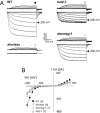Plant adaptation to fluctuating environment and biomass production are strongly dependent on guard cell potassium channels
- PMID: 18367672
- PMCID: PMC2278230
- DOI: 10.1073/pnas.0709732105
Plant adaptation to fluctuating environment and biomass production are strongly dependent on guard cell potassium channels
Abstract
At least four genes encoding plasma membrane inward K+ channels (K(in) channels) are expressed in Arabidopsis guard cells. A double mutant plant was engineered by disruption of a major K(in) channel gene and expression of a dominant negative channel construct. Using the patch-clamp technique revealed that this mutant was totally deprived of guard cell K(in) channel (GCK(in)) activity, providing a model to investigate the roles of this activity in the plant. GCK(in) activity was found to be an essential effector of stomatal opening triggered by membrane hyperpolarization and thereby of blue light-induced stomatal opening at dawn. It improved stomatal reactivity to external or internal signals (light, CO2 availability, and evaporative demand). It protected stomatal function against detrimental effects of Na+ when plants were grown in the presence of physiological concentrations of this cation, probably by enabling guard cells to selectively and rapidly take up K+ instead of Na+ during stomatal opening, thereby preventing deleterious effects of Na+ on stomatal closure. It was also shown to be a key component of the mechanisms that underlie the circadian rhythm of stomatal opening, which is known to gate stomatal responses to extracellular and intracellular signals. Finally, in a meteorological scenario with higher light intensity during the first hours of the photophase, GCK(in) activity was found to allow a strong increase (35%) in plant biomass production. Thus, a large diversity of approaches indicates that GCK(in) activity plays pleiotropic roles that crucially contribute to plant adaptation to fluctuating and stressing natural environments.
Conflict of interest statement
The authors declare no conflict of interest.
Figures





Similar articles
-
Dominant negative guard cell K+ channel mutants reduce inward-rectifying K+ currents and light-induced stomatal opening in arabidopsis.Plant Physiol. 2001 Oct;127(2):473-85. Plant Physiol. 2001. PMID: 11598222 Free PMC article.
-
Expression of a Cs(+)-resistant guard cell K+ channel confers Cs(+)-resistant, light-induced stomatal opening in transgenic arabidopsis.Plant Cell. 1997 Oct;9(10):1843-57. doi: 10.1105/tpc.9.10.1843. Plant Cell. 1997. PMID: 9368418 Free PMC article.
-
Overexpression of plasma membrane H+-ATPase in guard cells promotes light-induced stomatal opening and enhances plant growth.Proc Natl Acad Sci U S A. 2014 Jan 7;111(1):533-8. doi: 10.1073/pnas.1305438111. Epub 2013 Dec 23. Proc Natl Acad Sci U S A. 2014. PMID: 24367097 Free PMC article.
-
Signal transduction and ion channels in guard cells.Philos Trans R Soc Lond B Biol Sci. 1998 Sep 29;353(1374):1475-88. doi: 10.1098/rstb.1998.0303. Philos Trans R Soc Lond B Biol Sci. 1998. PMID: 9800209 Free PMC article. Review.
-
Abscisic acid and CO2 signalling via calcium sensitivity priming in guard cells, new CDPK mutant phenotypes and a method for improved resolution of stomatal stimulus-response analyses.Ann Bot. 2012 Jan;109(1):5-17. doi: 10.1093/aob/mcr252. Epub 2011 Oct 12. Ann Bot. 2012. PMID: 21994053 Free PMC article. Review.
Cited by
-
BCL2-ASSOCIATED ATHANOGENE4 Regulates the KAT1 Potassium Channel and Controls Stomatal Movement.Plant Physiol. 2019 Nov;181(3):1277-1294. doi: 10.1104/pp.19.00224. Epub 2019 Aug 26. Plant Physiol. 2019. PMID: 31451552 Free PMC article.
-
Plant ion channels: gene families, physiology, and functional genomics analyses.Annu Rev Physiol. 2009;71:59-82. doi: 10.1146/annurev.physiol.010908.163204. Annu Rev Physiol. 2009. PMID: 18842100 Free PMC article. Review.
-
SAUR proteins and PP2C.D phosphatases regulate H+-ATPases and K+ channels to control stomatal movements.Plant Physiol. 2021 Feb 25;185(1):256-273. doi: 10.1093/plphys/kiaa023. Plant Physiol. 2021. PMID: 33631805 Free PMC article.
-
GOLDEN 2-LIKE transcription factors for chloroplast development affect ozone tolerance through the regulation of stomatal movement.Proc Natl Acad Sci U S A. 2016 Apr 12;113(15):4218-23. doi: 10.1073/pnas.1513093113. Epub 2016 Mar 28. Proc Natl Acad Sci U S A. 2016. PMID: 27035938 Free PMC article.
-
Interactions between circadian and hormonal signalling in plants.Plant Mol Biol. 2009 Mar;69(4):419-27. doi: 10.1007/s11103-008-9407-4. Epub 2008 Oct 15. Plant Mol Biol. 2009. PMID: 18855103 Review.
References
-
- Hetherington AM. Guard cell signaling. Cell. 2001;107:711–714. - PubMed
-
- Assmann SM, Wang X-Q. From milliseconds to millions of years: Guard cells and environmental responses. Curr Opin Plant Biol. 2001;4:421–428. - PubMed
-
- Blatt MR. Cellular signaling and volume control in stomatal movements in plants. Annu Rev Cell Dev Biol. 2000;16:221–241. - PubMed
-
- Roelfsema MR, Hedrich R. In the light of stomatal opening: New insights into ‘the Watergate’. New Phytol. 2005;167:665–691. - PubMed
-
- Schroeder JI, Allen GJ, Hugouvieux V, Kwak JM, Waner D. Guard cell signal transduction. Annu Rev Plant Physiol Plant Mol Biol. 2001;52:627–658. - PubMed
Publication types
MeSH terms
Substances
LinkOut - more resources
Full Text Sources
Other Literature Sources
Molecular Biology Databases
Miscellaneous

